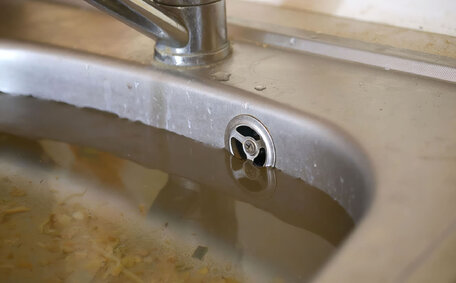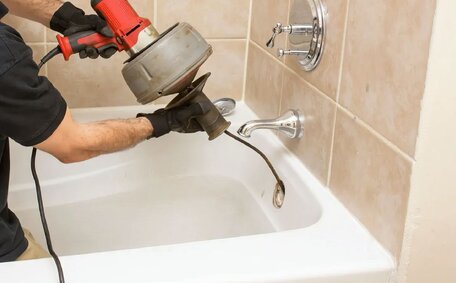Common sources of sediment causing drain blockages
Sediment accumulation in drains is significantly contributed to by construction sites and urban runoff. The rapid infrastructure and housing developments in the Hornsby region are notably increasing sediment’s impact on drainage systems.
Fine sediment deposits in urban areas result from the runoff of roads, footpaths, and rooftops, carrying tyre and brake wear, litter, and organic matter. This sediment can swiftly accumulate when washed into drains by rainfall. Over time, a mix of sand, soil, sediments and debris collects in drains and pipes, eventually blocking water flow.
Soil erosion during storms is another contributor to sediment pollution and subsequent drain blockages. Sites with exposed earth or under rehabilitation are vulnerable, with topsoil easily washed away. Waterways can then become choked with eroded soil, threatening their ecological balance.
The resulting buildup of sediment, if unchecked, will lead to complete drain blockages. By understanding common sources like construction, urban runoff and erosion, steps can be taken to mitigate risks and keep drainage systems operating smoothly.
Environmental impacts of sediment pollution
Sediment pollution severely compromises water quality and aquatic ecosystems, reducing fish egg and larvae survival rates.
An excess of sediment in waterways raises turbidity, which diminishes light penetration. Murky waters hinder plant photosynthesis, thereby disrupting aquatic food webs.
Research shows high sediment loads can smother riverbeds, degrading habitat for bottom-dwelling organisms that fish and waterbirds rely on for food. Metals and nutrients binding to sediment particles exacerbate water contamination issues.
Nutrient surges often trigger algal blooms. Decaying algae also release unpleasant odours. With aquatic ecosystems under strain, biodiversity suffers.
Algal blooms sap oxygen from the water, creating anoxic zones.
Sediment pollution via urban runoff, erosion and construction sites is preventable. Maintaining vegetation cover, sediment traps, runoff diversions and site rehabilitation controls sediment flows. Keeping waterways sediment-free preserves ecological health and function.
Preventing sediment from entering drainage systems
Preventing sediment from reaching drainage systems is crucial to avoid blockages. This requires controlling sediment at the source before it can wash into drains.
Sediment can be captured before it enters watercourses or drains by using sedimentation tanks, traps, and filters. For new commercial projects or stormwater outlets, Foruben Plumbing suggests deploying sediment tanks.
Sediment tanks function by separating sand, silt, and soil, and require regular maintenance to ensure effectiveness.
Commercially available stormwater treatment devices also filter sediment and organic matter. Continuous deflexion separation (CDS) units whirl incoming stormwater, accelerating sedimentation. Installation at drain entry points prevents sediment ingress.
Silt fences provide cost-effective sediment control for construction sites or saturated areas. Woven geotextile fabric traps sediment particles while allowing water to pass through. Simple to deploy, silt fences require anchoring with stakes and proper maintenance.
Establishing hardy vegetation stabilises soil, reducing erosion during storms. Densely planted buffer strips along waterways or under rehab act like filters, slowing runoff velocity so sediments settle out. Choice of vegetation should consider local climate, soil types, and sun exposure.
In residential areas, sediment traps like check dams lined with weed mats in gardens and driveways effectively capture eroded material.
These combined measures help maintain sediment-free drainage systems, ensuring optimal flow and protecting aquatic ecosystems.
Clearing blocked drains caused by sediment
Prompt removal of sediment buildup is critical to averting serious blockages. Foruben Plumbing advises professional drain inspections, especially between July and September when sediment levels typically increase.
Quick action is necessary to resolve drain blockages before they result in property damage. Begin with a drain snake or plunger to dislodge obstructions. Take care not to compact sediment further and completely remove all loosened debris.
Mechanical water jet drain cleaning performed by trained technicians is advised for addressing severe sediment blockages. High-pressure water jets scour pipe walls, flushing away sediment, roots, grease and hardened debris. CCTV drain inspections check clearing effectiveness, identifying if follow-up jetting is needed.
Silt bags inserted inside drains capture sediments before they accumulate. Mesh bags sit below drain grates, filtering runoff. Silt bags placed in drains, when emptied regularly, effectively capture sediment and prevent pipe buildup.
By regularly desludging drainage systems and installing protective measures like silt bags, sediment buildup can be offset. Promptly addressing any sediment-based drain blockages preserves infrastructure integrity and household plumbing.
Long-term sediment control strategies
The implementation of comprehensive sediment control strategies is vital for long-term reduction of sediment in local drainage systems. This requires coordinated efforts across councils, developers, businesses and residents to address sediment pollution at multiple fronts.
Construction sites require sediment control plans as part of sustainable land use and development regulatory requirements. Staged site rehabilitation using mulch and vegetation aids in early ground stabilisation.
Optimal site planning reduces exposed soil by using sediment fences, drain guards, and turf buffers to contain erosion.
Implementing WSUD principles, such as employing vegetated swales, rain gardens, and wetlands, effectively filters sediment and repurposes stormwater for irrigation. Designing separate drainage pathways for sediment-laden runoff avoids contamination of existing networks.
Intelligent road design can reduce vehicle-induced sediment loads. Sweeping programmes maintain clean surfaces, while grassy road verges filter tyre particulates and brake dusts from runoff. Gross pollutant traps capture litter.
Councils can step up street sweeping frequencies and install gross pollutant traps to filter sediment. Additionally, community education on sediment disposal and reporting illegal dumping are pivotal for waterway protection.
Businesses should install sediment bags in vulnerable drains and divert runoff towards sediment ponds for effective capture.
Ensure spill kits are on hand to contain leaks or chemical contamination of soils. Fence equipment storage areas to prevent wind or water transport of loose materials.
Residents can contribute by installing sediment bags before monsoon season and preserving vegetation buffers to reduce erosion and uphold soil stability. Use porous paving alternatives to maximise stormwater infiltration over runoff.
Employing these control strategies helps to lower sediment in watercourses and drainage systems, safeguarding environmental and public health and reducing drain maintenance.
When to call a professional for sediment-related blockages
Homeowners should promptly contact a professional if repeated DIY efforts fail to clear drain blockages, as this indicates a persistent sediment issue.
Recurring drainage problems after repairs suggest ongoing sediment issues, highlighting the need for preventive measures like silt fences or sediment traps.
Plumbers have specialised jetting equipment and CCTV cameras to thoroughly clear stubborn sediment blockages beyond DIY methods. They can also provide expert drainage system inspections and maintenance to offset sediment risks.
For advice installing sediment control measures or to book a professional drain inspection, contact Hornsby Plumbing on 1300 349 338 or [email protected].
Our skilled team, armed with advanced jetting tools, excels in resolving sediment blockages for unobstructed drains.






